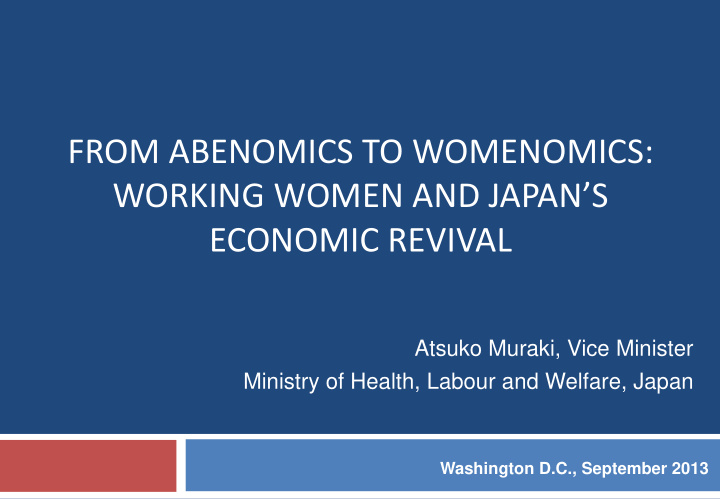



FROM ABENOMICS TO WOMENOMICS: WORKING WOMEN AND JAPAN’S ECONOMIC REVIVAL Atsuko Muraki, Vice Minister Ministry of Health, Labour and Welfare, Japan Washington D.C., September 2013
Key indices of international gender equality (2012) HDI GII GGI Human Development Index: Gender Inequality Index: Gender Gap Index: 10 th out of 187 countries 21 st out of 148 countries 101 st out of 135 countries Rank Country HDI Rank Country GII Rank Country GGI 1 Norway 0.955 1 The Netherlands 0.045 1 Iceland 0.864 2 Australia 0.938 2 Sweden 0.055 2 Finland 0.845 3 United States 0.937 3 Switzerland 0.057 3 Norway 0.840 4 The Netherlands 0.921 3 Denmark 0.057 4 Sweden 0.816 5 Germany 0.920 5 Norway 0.065 5 Ireland 0.784 6 New Zealand 0.919 6 Germany 0.075 6 New Zealand 0.781 7 Ireland 0.916 6 Finland 0.075 7 Denmark 0.778 7 Sweden 0.916 8 Slovenia 0.080 8 Philippines 0.776 … … … … … … 9 Switzerland 0.913 10 Japan 0.912 21 Japan 0.131 101 Japan 0.653 HDI measures human development by combining three GII captures the loss of achievement due to gender GGI measures a country’s gender gap by dimensions (indicators in brackets): inequality using three dimensions (indicators in brackets): calculating a general score from weighted data 1. Health (Life expectancy at birth) 1. Reproductive health (adolescent fertility, maternal from the four fields of Economy, Education, 2. Education (Mean years of schooling and expected mortality) Health and Politics. 0 indicates complete years of schooling) 2. Empowerment (educational attainment, secondary inequality, 1 complete equality. 3. Living standards (GNI per capita (PPP US$)) level and above, parliamentary representation) 3. Labor market (labor force participation) Sources: The Human Development Report , United Nations Development Programme (UNDP); The Global Gender Gap Report 2012 , World Economic Forum
Female employment rates by age group (2011) (%) France 90 United States Sweden 80 70 Japan 60 50 Japan South Korea Japan (2001) United States 40 France 30 Sweden South Korea 20 Japan (2001) 10 0 15 - 19* 20 - 24 25 - 29 30 - 34 35 - 39 40 - 44 45 - 49 50 - 54 55 - 59 60 - 64 65+** Source: JILPT Databook of International Labor Statistics 2013 * Data is for ages 16–19 in the cases of the United States and Sweden. ** Data is for ages 65–74 in the case of Sweden.
Total fertility rates and female employment rates of selected OECD member countries (2010) 2.4 2.2 Iceland Sweden United Kingdom Total fertility rate 2.0 France Norway United States OECD average Australia Denmark (34 countries) 1.8 Finland Canada 1.6 Greece 1.4 Italy Germany Japan Spain South Korea 1.2 1.0 50.0 60.0 70.0 80.0 90.0 Employment rate of women aged 25–54 years (%) Notes: *The OECD average female employment rate for ages 25 – 54 is from OECD’s Employment Outlook 2011, the rest are from OECD’s Family Database. **The figures for Canada are from 2009.
Women in leadership positions in Japan Diet members (Lower House) 7.9% Diet members (Upper House) 18.2% Director position and above 6.9% (private enterprises)* Director position and above 2.6% (national civil service) Judges 17.7% Medical doctors** 18.9% Pharmacists** 66.8% 0% 10% 20% 30% 40% 50% 60% 70% 80% Source: Gender Equality Bureau Cabinet Office, December 14, 2012. * Data is from 2011, * * Data is from 2010.
FROM ABENOMICS TO WOMENOMICS: WORKING WOMEN AND JAPAN’S ECONOMIC REVIVAL Atsuko Muraki, Vice Minister Ministry of Health, Labour and Welfare, Japan Washington D.C., September 2013
Recommend
More recommend